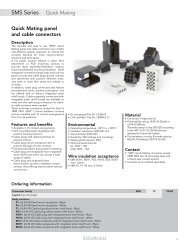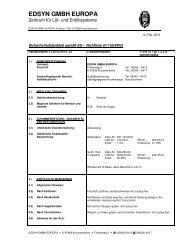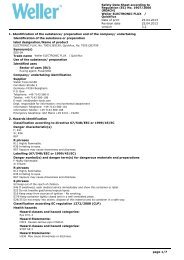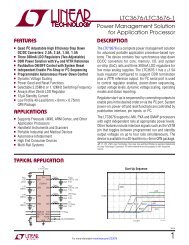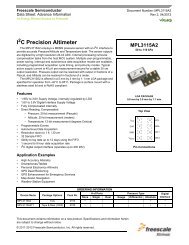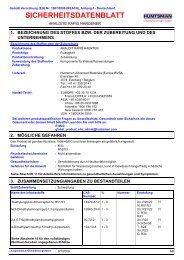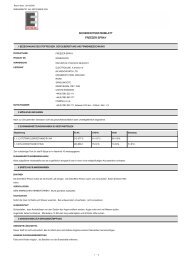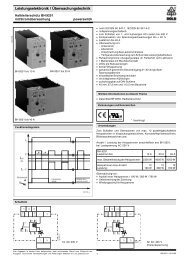LP3947 USB/AC Adaptor, Single Cell Li-Ion Battery ... - Farnell
LP3947 USB/AC Adaptor, Single Cell Li-Ion Battery ... - Farnell
LP3947 USB/AC Adaptor, Single Cell Li-Ion Battery ... - Farnell
Create successful ePaper yourself
Turn your PDF publications into a flip-book with our unique Google optimized e-Paper software.
<strong>LP3947</strong><br />
Application Notes (Continued)<br />
TABLE 2. LED Indicator Summary<br />
RED LED GREEN LED<br />
(CHG)<br />
(EOC)<br />
Charger Off OFF OFF<br />
Charging <strong>Li</strong> <strong>Ion</strong> <strong>Battery</strong>* ON OFF<br />
Maintenance Mode OFF ON<br />
Charging <strong>Li</strong> <strong>Ion</strong> <strong>Battery</strong> after Passing Maintenance Mode OFF ON<br />
EN Pin = LOW OFF ON<br />
LDO Mode OFF OFF<br />
5.6 Hr Safety Timer Flag/<strong>Battery</strong> Temperature Violation<br />
* Charging <strong>Li</strong> <strong>Ion</strong> battery for the first time after VCHG-IN insertion.<br />
ON ON<br />
Ts PIN<br />
The <strong>LP3947</strong> continuously monitors the battery temperature<br />
by measuring the voltage between the Ts pin and ground.<br />
Charging stops if the battery temperature is outside the<br />
permitted temperature range set by the battery’s internal<br />
thermistor RT and the external bias resistor RS. A 1% precision<br />
resistor should be used for RS. A curve 2 type thermistor<br />
is recommended for RT. The voltage across RT is proportional<br />
to the battery temperature. If the battery temperature is<br />
outside of the range during the charge cycle, the <strong>LP3947</strong> will<br />
suspend charging. As an example, for a temperature range<br />
of 0˚C to 50˚C, a 10kΩ for the thermistor and a 4.1kΩ for Rs should be used. When battery temperature returns to the<br />
permitted range, charging resumes from the beginning of the<br />
flow chart and the 5.6 hr safety timer is reset. Refer to Figure<br />
3. <strong>LP3947</strong> Charger Flow Chart for more information.<br />
In absence of the thermistor, Ts pin will be pulled high to VT<br />
and the <strong>LP3947</strong> goes into LDO mode. In this mode, the<br />
internal power FET provides up to 1.2 amp of current at the<br />
BATT pin. The LDO output is set to 4.1V or 4.2V, depending<br />
on the programmed battery regulation voltage. When operating<br />
at higher output currents, care must be taken not to<br />
exceed the package power dissipation rating. See “Thermal<br />
Performance of LLP Package” section for more detail.<br />
Charger Status in Relation to Ts Voltage<br />
Voltage on the Ts Pin Charger Status<br />
Ts ≥ 2.7V LDO Mode<br />
www.national.com 10<br />
Voltage on the Ts Pin Charger Status<br />
2.427v ≤ Ts < 2.7V<br />
0V ≤ Ts ≤ 1.39V<br />
Charger Off<br />
1.39V < Ts < 2.427V Charger On<br />
LDO MODE<br />
The charger is in the LDO mode when the Ts pin is left<br />
floating. This mode of operation is used primarily during<br />
system level testing of the handset to eliminate the need for<br />
battery insertion. CAUTION: battery may be damaged if<br />
device is operating in LDO mode with battery connected.<br />
The internal power FET provides up to 1.2 amp of current at<br />
BATT pin in this mode. The LDO output is set to 4.1V. When<br />
operating at higher output currents, care must be taken not<br />
to exceed the package power dissipation rating. See “Thermal<br />
Performance of LLP Package” section for more detail.<br />
EN PIN<br />
The Enable pin is used to enable/disable the charger, in both<br />
the charger mode and the LDO mode, see Figures 5, 6. The<br />
enable pin is internally pulled HIGH to the CHG-IN pin. When<br />
the charger is disabled, it draws less than 4 µA of current.




